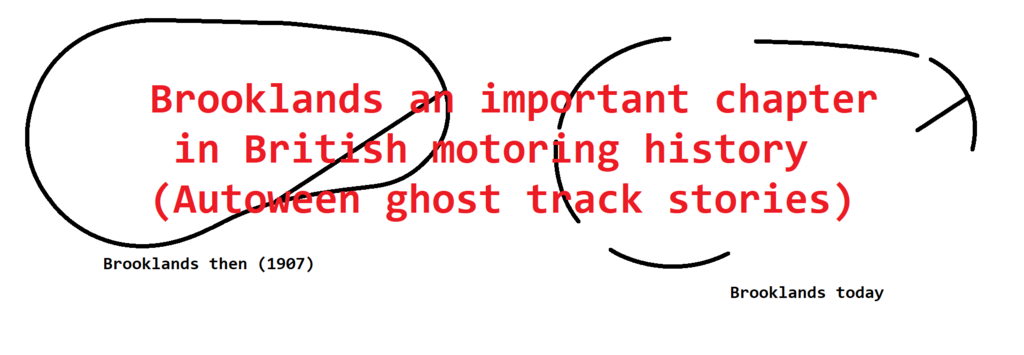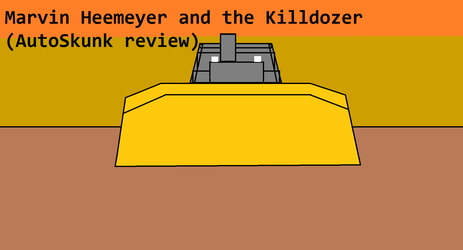Sign In
CloseBrooklands-the first purpose built track (AutoSkunk Review) by ShawnSkunk
October's here, which means it's that time of the year again to tell another ghost story...a ghost track story X3
this time we're going Surrey England, to take a look at one of the most famous racetracks in history, the Brooklands race track, England's first racetrack.
it's been 82 years years now it hosted it's last race back in 1939.
now today it's a museum curating to automotive and aviation history, there's even an airpad displaying a variety of historic planes including one of the Concorde supersonic passenger jets.
Brooklands was more than just a track, it was also one of Britian's first airfields and a flight training center as well which became their largest aircraft manufacturing centre in 1918,
producing various types of aircraft such as the Wellington, and even civil airliners like the Vickers Viscount and the VC-10 anothers vickers model.
the 1900's: a King's proposal for a racetrack:
I remember it like it was the dawn of the 20th century again, the Motor Car Act was enacted in England in 1903, which mandated for the first time, vehicle registration, driver's licensing,
and posted speed limits.
during a time when 50% of Britian's cars were built in and came from France, France back then at during the early years of the automobile was essentially the Detroit of Europe and it was
one of the biggest automotive markets.
getting back to the story, there was a problem, Britian was becoming subject to enforced 20 MPH speed limits on public roads and because there were no ractracks back then (not yet at least),
this would pose a problem on Britians then infant auto industry, this new act would hinder their ability to legally conduct sustained high speed testing on new cars, they new that they needed
a solution and soon.
enter Hugh F. Locke King stage right, a British entrepenuer, he proposed the idea for a purpose built racetrack with banked turns, (predating today's nascar banked oval tracks).
King commissioned Colonel Capel Loft Holden of the Royal Artillery to design the track and work soon began in 1906.
the only requirements were for speed and spectator visability, so the Colonel designed a track that was 100 feet wide, 2.75 miles long, and the banking was nearly 30 feet high in places.
in addition to the oval, a finishing straight was built, further increasing the overall length of the track to 3.25 miles, with 1.25 miles of it being banked, in it's heyday, the track
could play host for up to 287,000 spectators.
however the constuction wasn't all that easy as far as paving track went, a road surfacing material called tarmacadam was used on the banking, and asphalt was originally thought for paving
the rest of the track but that idea was scrapped for being too expensive, so instead of asphalt, the rest of the track was paved in uncoated concrete, this would in later years as a result
lead to a rough and bumpy ride as the concrete would overtime suffer from differential settlement.
but in the end, the work was finished and the track was ready for it's official opening in 1907, and they called their new racetrack Brooklands, a name that will forever be immortalized in
history and legend.
completing the track was a dotted line that ran along the center of the track called "the fifty foot line", how this line worked theoretically was when you drove over that line, the driver
would be able to take on the banked turns without having to use steering wheel.
on June 17, 1907, the Brooklands track opened with an official luncheon attended by most of Britian's car makers, at the conclusion of the luncheon, Locke King (whose had the track buily on
his estate) named Lord Montagu of Beaulieu, Messrs. Hugh Owen, Julian Walter Orde (secretary of the Automobile Club of Great Britain and Ireland) and Colonel Holden as being the main
people that enabled the track to be built.
This was followed by an informal inauguration of the track by a procession of 43 cars, one driven by Charles Rolls, a motoring and aviation pioneer, and a co-founder of Rolls-Royce.
The first competitive event was held on June 28-29, with three cars competing to break the world record for distance covered in 24 hours, and the first race meeting was held on 6 July,
attracting over 10,000 spectators.
a couple of sidenotes I like to mention is that Brooklands apparently inspired the creation another famous racetrack, in the United States, the indianapolis Motor Speedway which held it's
inaugural race a couple of years later in August 1909 in Inidianapolis, Indiana, the home of the infamous Indianapolis 500.
and the other sidenote?, a mountain circuit, Brooklands also featured a small section of racetrack called the Brooklands Mountain Circuit, it provided an extra one and a quater miles of track
running from the fork, to the rear of Member's hill and back, it was created in 1930 using movable barriers.
racing records:
okay getting back to the story now.
getting back on June 28-29 1907, the first race was held on the new Brooklands track, more than that, Brooklands was the birthplace of the idea of a 24 hour endurance race, so Brookland's
first race was not only it's first race, it was also the very first 24 long endurance race, the spectators loved it and so did the drivers, and so the concept of a 24 hour endurance race was
here to stay, driver Selwyn Edge lead the race with three specially converted Napier cars around the track.
a statement had been made a year prior in 1906 and Selwyn entered into physical training program to prepare for the event, his car, an 804, was extensively modified, having a special fuel
tank, bodywork removed, and a special windscreen.
over 300 red railway lamps were used to light the track during the night, flares were used to mark the upper boundary of the track, edge drove his car for the full duration, with the
drivers of the other two cars (Henry C. Tryon/A. F. Browning and F. Draper/Frank Newton) taking the more familiar shift approach.
during the event Edge covered a distance of 1,581.74 mi (2,545.56 km) at an average speed of 65.91 mph (106.07 km/h), comfortably beating the existing record of 1,096.187 mi (1,764.142 km)
set at Indianapolis in 1905.
women were not allowed to compete for several years, Dorothy Levitt, Britian's first female racer, was refused entry despite having been the 'first English-woman to compete in a motor
race' in 1903, and holding the 'Ladies World Land Speed Record'.
Edge completed 2,545 km at an average 106.06 km/h, a record which stood for 17 years, the first standard race meeting would be held the next week, on July 6.
in 1912, George E. Stanley broke the one-hour record at Brooklands race track on a Singer motorcycle, becoming the first ever rider of a 350 cc motorcycle to cover over 60 miles in an hour.
the world record for the first person to cover 100 miles in 1 hour was set by Percy E. Lambert at Brooklands, on February 15, 1913 when driving his 4.5 litre sidevalve Talbot.
He actually covered 103 miles, 1470 yards in 60 minutes, a contemporary film of his exploits on that day can be viewed at the Brooklands Museum.
another record to consider that was set at Brooklands, is the record for the youngest driver to drive a lap there, Ivy Cummings is thought to be the youngest person to complete a lap when
in 1913, it is rumored that the driver unbelievably was either 11 or 12 years old (and I thought I was youngest guy in the world around the time I took my first drive in my dad's old white
1994 Ford Escort 5-speed, oh wait, I still am, I was 8 years old when I took my first drive, eat your heart out Ivy), though it was not staged by anyone for him to do that, she actually
took her father Sydney Cumming's car while her father was bird-watching aircraft and drove around the Brooklands circuit, nice babysitting Sydney, jolly good job X3
aside from kids secretly driving their dad's cars while their dads aren't looking, there are also distance records that were set at Brooklands.
In July and August 1929, Violette Cordery (another lady driver) and her younger sister Evelyn drove her 4.5 litre four-seater Invicta for 30,000 miles in less than 30,000 minutes
(driving in 20 days and 20 hours), averaging 61.57 mph and earning her second Dewar Trophy from the Royal Automobile Club, and then it all came to an end.
in July 2014, world war 1 (known as the great war) began, Brooklands closed to motor racing during World War 1, was requisitioned by the War Office and continued its pre-war role as a
flying training centre although it was now under military control, Brooklands soon became a major location for the construction, testing and supply of military aeroplanes.
after the war ended in 1918, racing at Brooklyns resumed a couple of years later in 1920 after some extensive track repairs and in 1926 Grand Prix Racing was established at Brooklands
by Henry Segrave (an early British poineer in land and water speed record setting), after his victories in the 1923 French Grand Prix and the San Sebastián Grand Prix
(all won on Sunbeam Racing Cars which in various hands had significant success in Brooklands) the following year raised interest in the sport in Britain.
the first British Grand Prix was won by Louis Wagner and Robert Sénéchal, sharing the drive in a Delage 155B, the second British Grand Prix was staged there in 1927 and these two events
resulted in improved facilities at Brooklands.
in 1930, the Daily Herald offered a trophy for the fastest driver at an event at Brooklands, the first year, Birkin and Kaye Don competed, the former in a Bentley Blower tourer,
the latter in the Sunbeam 'Tigress' 4 litre, Don winning with a speed of 137.58 miles per hour.
in 1932, Birkin won driving his red "Monoposto" Bentley Blower No.1, clocking 137.96 miles per hour, the track record stood for two years, before being beaten by John Cobb driving the
24 litre Napier-Railton, which holds the all-time lap record at 143.44 mph.
in 1932 the Junior Car Club organised the British 1000 Miles Race, which was held in two parts on 3 and 4 June, the race was won by Mrs E. Wisdom and Miss Joan Richmond
driving a Riley Brooklands 9.
during the late 1930s, Brooklands also hosted massed start cycle racing events organised by the National Cyclists' Union (as the sport's governing body, the NCU banned such events
from public roads).
in 1939, it was used as a location for the Will Hay film, Ask a Policeman, an episode in Johannes V. Jensen's novelle Gudrun from 1936 takes place at the race track.
but once all of this activity including motor racing came to a halt by September 1939, when the sounds of movie cameras, revving engines, cheering crowds were replaced by the sounds
of guns, artillery, and bombs, world war 2 had begun and the site was turned over to military aircraft production, during the war, parts of the track were damaged by bombs from Luftwaffe
bombing raids over Britian and a new access road to the aircraft plant was cut through the track from a nearby road called Oyster Lane, temporary disperal hangars covered other sections
of the track, but unfortunately, the track would never racing activities afterwards, even after the war's end.
Brooklands Part 2: the aero side of the story:
like I mention earlier, Brooklands is also an airfield and was a major aircraft manufacturing hub.
in 1908, Alliott Verdon-Roe was based at Brooklands and carried out the first taxiing and towed flight trials of a British full-size powered aircraft by a British pilot.
on October 29, 1909, the first official powered flight at Brooklands was made by Frenchman Louis Paulhan and his Farman biplane: this special event attracted 20,000 people and was the
first public flying display at Brooklands.
operating from specially prepared land inside the Race Track and given his own aeroplane shed, Paulhan made a series of flights on the following days, flying to a height of some 720 ft
on Saturday and he set a new British endurance record of nearly 3 hours (2 hours 49 minutes and 20 seconds) on Monday.
through 1910, Brooklands quickly became a major center for flying in the summer, Hilda Hewlett and Gustave Blondeau opened Britain's first flying school at Brooklands.
Hewlett and Blondeau also started their aircraft manufacturing company, Hewlett & Blondeau Limited there before moving to larger premises in Clapham in London.
later in 1910, Bristol Aeroplanes also established a flying school, its first instructor and test pilot was Archie Low, Roe also started a flying school there.
Vickers opened a flying school on 20 January 1912, and among its first instructors was R. Harold Barnwell; 77 pupils including Hugh Dowding were taught to fly until the school closed
in August 1914.
in February of 1912, Thomas Sopwith opened his own flying school and later in June, along with several others, he started his own company there, the Sopwith Aviation Company, although
their manufacturing premises were located at Kingstom upon Thames (don't ask, I don't name the towns in England).
other aviation pioneers came to Brooklands before World War One including Prince Serge de Bolotoff who tried to build a large tandem triplane in a shed there in 1913.
Blériot, Martinsyde and Vickers also later produced military aeroplanes at Brooklands which became Britain's largest aircraft manufacturing centre by 1918, many flying schools operated
here before 1914 and the aerodrome became a major flying training centre between the wars.
the great war:
when World War One began in 1914, Brooklands closed to motor racing and was requisitioned by the war office, Vickers set up shop in 1915, and Brooklands soon became a major aircraft
manufacturing center, building, developing, and testing aeroplanes.
civillian flight schools were either shut down or were merged into a millitary flying shcool and flight training continued until the end of the 1915.
several Royal Flying Corps squadrons including numbers 1, 8, 9 and 10 (plus No. 2 and 23 Reserve Squadrons) were formed (or reformed) and based briefly at Brooklands during the war years.
continuing significant pioneering air-ground wireless trials pioneered by a Marconi team at Brooklands from 1912, the aerodrome also housed various RFC units testing and training with
airborne wireless communications equipment and the World's first voice to ground wireless message was successfully transmitted over Brooklands in 1915.
major changes were made to the Flying Village with the construction in late 1917 of three large 'Belfast-truss' General Service Sheds for a new Aircraft Acceptance Park (later No. 10 AAP),
this handled the assembly and testing of large numbers of new aeroplanes and finally closed in early 1920.
the post great war years:
after World War One had ended in 1918, Brooklands Aviation Ltd was formed in 1931 - with Percy Bradley, Duncan Davis, Fred Sigrist and Ted Jones as Directors - to operate the aerodrome,
and commissioned British airport architect Graham Dawbarn to design the Art Deco Brooklands Aero Clubhouse, which opened in May 1932.
the company also operated the resident Brooklands School of Flying which was registered as a limited company in 1931 with Duncan Davis and Ted Jones as Directors, as well as those at
Lympne, Shoreham and Sywell Aerodromes in the later 1930's.
the original pre-WW1 Brooklands Aero Club was re-formed by the BARC in May 1930 with Percy Bradley as Manager and the Brooklands Flying Club was established by Brooklands Aviation in early
1933.
Brooklands Aviation won a War Department contract for pilot training for the Royal Air Force, and opened No. 6 Elementary Flying Training School at Sywell on 10 June 1935, training pilots
with a fleet of 20 de Havilland Tiger Moths, and in 1937 the RAF Volunteer Reserve School was set up at Sywell with a further 16 training aircraft.
during WW2, Brooklands Aviation became a contractor to the Civilian Repair Organisation, repairing various types of damaged aircraft, particularly Vickers Wellingtons. After ending it's
RAF flying training in 1946, the company diversified and built plywood and GRP cabin cruiser boats designed by Alan Eckford, until 1974, The first flight of the Hawker Hurricane, later a
fighter aircraft in the Battle of Britain, occurred at Brooklands on 6 November 1935.
world war 2:
in September 1939, world war 2 began, and Brooklands was once again requsitioned for war time aircraft production, in particular the Vickers Wellington, Vickers Warwick and Hawker Hurricane
and was extensively camouflaged.
trees were also planted in some sections of the concrete track to help conceal the Hawker and Vickers aircraft factories there.
despite these efforts, the Vickers factory was successfully bombed by the Luftwaffe and extensively damaged on 4 September 1940 with nearly 90 aircraft workers killed and at least 419
injured.
five unidentified victims were buried in unmarked graves in Burvale Cemetery, Hersham, on 9 September although one of these was later confirmed to be 36 year old William E Hunt.
On 10 March 2016, thanks to the efforts of local residents, sponsors and supporters, permanent memorials to Mr Hunt and the other four civilians were dedicated by the Reverend Martin
Fletcher and Elmbridge Borough Councillor Mary Sheldon.
attendees included relatives of Vickers factory worker Eric S Powell who also died on 4 September 1940 aged 26 and is now believed to be one of the remaining four unidentified casualties
buried at Burvale.
the Hawker factory premises were also bombed and damaged two days later but with no loss of life or serious disruption to Hurricane production, on September 21, 1940,
Lt John MacMillan Stevenson Patton of the Royal Canadian Engineers risked his life when he and five others manhandled an unexploded German bomb away from the Hawker aircraft factory at
Brooklands and rolled it into an existing bomb crater where it later exploded harmlessly - his bravery was subsequently recognised by the award of the George Cross.
the crucial role of Brooklands in the Battle of Britain of 1940 is further explained in displays at Brooklands Museum.
after the bombing of Brooklands in September 1940, the Vickers-Armstrongs Design Department (including Rex Pierson, Barnes Wallis and several hundred others) was dispersed to a secret
location at the nearby Burhill Golf Course, just east of St George's Hill in Hersham and the Experimental Department led by George Edwards was relocated to temporary premises at Foxwarren
in Redhill Road, Cobham.
these two facilities played a crucial part in the successful development of the 'Upkeep' mine - better known today as the 'bouncing bomb' conceived by Barnes Wallis and deployed to such
devastating effect by the 'Dambuster' Avro Lancasters of 617 Squadron, RAF, led by Guy Gibson against Germany's Ruhr Valley reservoirs on the night of 16–17 May 1943.
1945 and onward:
after the war, the circuit was in poor condition and it was sold to Vickers-Armstrongs in 1946 for continued use as an aircraft factory, new aircraft types including the Viking, Valetta,
Varsity, Viscount, Vanguard, 1-11 and VC10 were subsequently, designed, manufactured and delivered from there.
in 1951, construction of a new hard runway required a section of the motor circuit's Byfleet Banking to be removed to allow Vickers Valiant V bombers to be flown out to nearby Wisley
airfield which offered a longer runway and less built-up surroundings than Brooklands, This airfield opened as a flight test centre for Vickers in 1944 and used until 1972 (latterly by BAC).
after considerable expansion with increasing commercial success in the 1950s, the Vickers factory expanded to its peak size in the early 1960s in preparation for the VC10 manufacturing
programme and became the headquarters of the new British Aircraft Corporation in 1960.
substantial investment in the site at this time saw many new buildings constructed and also existing premises modified, first, in the mid-1950s, came a new assembly hall for the Vickers
Viscount known as 'B.1' (presumably as it consisted of a number of standard war-time B.1 type hangars re-used (together with some T.2 hangars too) and rebuilt as one long double bay
structure parallel to the runway.
a large new 60,378 sq ft VC10 flight shed hangar was ready to house the prototype VC10 airliner by 1962 and a second even larger (98,989 sq ft) flight shed was added alongside this by 1964.
the latter was probably the largest aircraft hangar in Europe at the time and became known locally as 'The Cathedral' hangar while the smaller shed was called 'The Abbey', the huge factory
at Brooklands went on to design and build the BAC TSR.2, One-Eleven and major assemblies for Concorde.
the cancellation of the V.1000 transport in 1955, the Labour government's cancellation of TSR-2 in 1965 and the disappointing lack of significant orders for VC10s and Concorde saw the
factory contract from the early 1970's.
It became part of the newly formed British Aerospace in 1977 and focused on component manufacture for other aircraft, however closure was announced on 29 July 1986, finally closing on
Christmas Day 1989, BAe's successor, BAE Systems, still retain a logistics centre at Brooklands today.
and these are things I remember about Brooklands, you can go visit Brooklands today, tour it's museum and see the historic race cars on display there and all the cool aircraft on display
outside.
and as for you little fella, insert image link here, it's time to re-live those glory days X3
"ahem!, what do you think you're doing?"
O_O
"that's museum property"
.....oh, weeelllll....I can't hear you VROOM!
"hey come back here!, SECURITY!"
well guys I hope enjoyed this years Autoween ghost track story, I may have just copy pasted most of the story from a Wikipedia article cause I didn't really much time to myself aside from being constantly paged by my mother for help as well as my job, but some of my writing in this is of my own work
also I found this article on a top ten list of abandoned tracks and Brooklands made number one the list, you can check it out here:
https://www.hotcars.com/15-images-o.....ty-disturbing/
also also, may not be doing very much AutoSkunk related work, I'm currently trying to study for a practice math test, my ged teacher is gonna try to get me graduated by the end of this and I just hope and pray I finally and not fail again for the umpteenth time, and that's about it, see you all next time :3
Submission Information
- Views:
- 184
- Comments:
- 0
- Favorites:
- 0
- Rating:
- General
- Category:
- Visual / Digital




